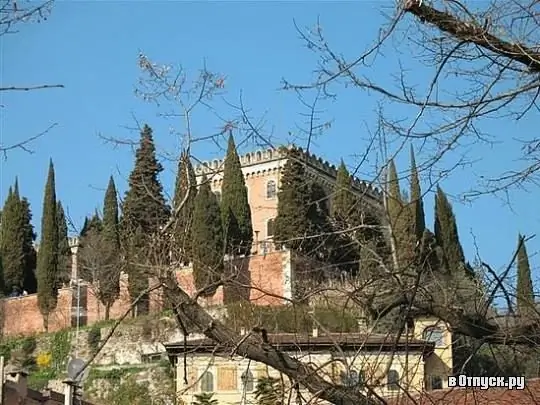
Description of the attraction
The Castle of St. Peter, erected on the hill of San Pietro in Verona, is a fortress that stands on the site of an ancient Roman temple. The site for the construction of the castle was not chosen by chance - a picturesque hill overlooking the Adige River and the entire city is an ideal strategic point. Already in the Iron Age, people lived here, which is confirmed by archaeological excavations. In the era of Ancient Rome, the first fortified structure was erected at the foot of the hill, with the help of which the passage through the Adige was controlled, and a little later on the opposite bank of the river a city appeared, which later became Verona. It is believed that the church dedicated to St. Peter, built here in the 8th century, stood on the site of an ancient Roman temple, the ruins of which could be seen until the early 19th century.
During the domination of the Venetian Republic, the castle of San Pietro with its internal buildings was the seat of the military commander of the city. Serious restoration work was carried out at the beginning of the 17th century, in particular, the premises for the soldiers were repaired, and in 1703 the infantry barracks were expanded - they could accommodate up to 460 people. Unfortunately, when at the beginning of the 19th century, power over the city fell into the hands of Napoleon, his troops destroyed most of the castle, as well as the church and watchtower, the ruins of which can still be seen at the fortress walls.
Between 1852 and 1858, at the direction of the Austrian Field Marshal Josef Radetzky, barracks were built on the territory of the castle, which still exist today and bear the obvious features of German architecture.
The wall surrounding the castle of San Pietro, due to the features of the relief, has an irregular elongated shape: it is straight on the west and south sides, and broken on the east. Initially, the wall was fortified with 12 towers - this can be seen from the stonework. Inside, at the northeastern corner, was the tallest tower, now destroyed. Two gates, equipped with drawbridges, were located on the east and south sides. A huge cistern, made in the 16th century and installed underground to provide soldiers with water, has survived to this day - it was transferred here from the church of San Pietro destroyed by the French.
In general, the castle of San Pietro, despite many years of abandonment, is well preserved: the inhabitants of Verona and numerous tourists love to visit the small square in front of the castle, as well as its surroundings, turned into a public park. In the 1920s, a funicular was even built, taking those who wish to the top of the hill, but for many years it has not functioned. Today, large-scale restoration work is being carried out within the walls of the castle itself, upon completion of which a new museum will be opened here.






